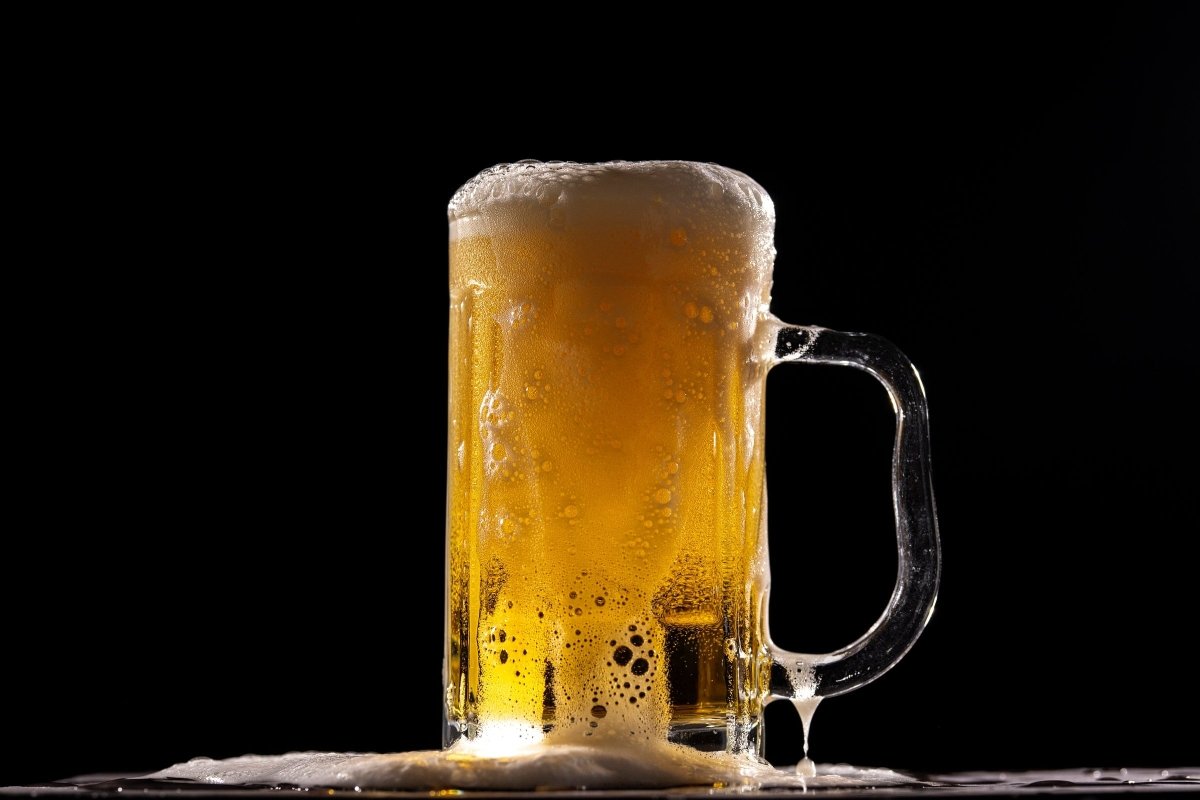Your cart is empty

All About Lager
Lager and the craft beer industry got off to a rather rocky start. After all, it was the industrial light pale lagers of America that US homebrewers and upstarts like New Albion, Anchor and Sierra Nevada were up against.
While over here, across the pond, rebellious real-ale drinkers were joining the likes of CAMRA in an attempt to save locally produced and full-flavoured ales. With the best intentions, it seemed that lager had been tossed aside as the inferior beverage.
In the crowds of beer enthusiasts, ‘lager’ had become a curse word, casting the sins of mass-produced flavourless light lagers upon the entire community of lager producers. However, most craft brewers knew that keeping a lager on in the brewpub was just good business. And while we're at it, why not make a f*cking good one!
Recently, we wrote about our rather successful outing at the European Beer Challenge where we medaled in nine(!) categories. Appropriately, four of our nine entries were lagers. Appropriate, because over here at Sheep in Wolf’s Clothing (SiWC), we love us some good lager!
So let’s take a look at how lager changed the world of beer...
What is Lager?
Here in the UK, it’s not uncommon to hear someone say something like “I don’t like beer, I prefer lager.” Contrary to popular belief, lager is beer. Lager differs from ale in that it is fermented Saccharomyces pastorianus, a close relative of Saccharomyces cerevisiae.
Because of this it is fermented at much cooler temperatures (10-14 °C) than ale (16-23 °C) and takes longer to completely attenuate. In other words, the yeast’s metabolism of wort sugars and uptake of nutrients takes longer at lower temperatures.

A glimpse of our refreshing non-alcoholic lager, Lager Day Saints
The etymology of the word lager comes from the German term lagern which means “to store.” This is because lager is stored at or near freezing temperatures for around 6-8 weeks. Historically, cold conditioning would take place in caves. Brewers would temper these natural cooling units with ice from nearby lakes and rivers.
During the holding period, many flavour compounds will completely drop out of the solution. The result of the ‘lagering’ process is a much more refined and clean-tasting beverage. Lagering elevates the crisp taste of pilsener/lager malt and the spicy aromatics of European noble hops.
A Mega Brief History of Lager
Today we can trace the origin of bottom-fermenting yeast in beer back to South America. Research has shown that S. eubayanus was brought over to Europe in the 15th century via trade with Argentina. On the continent, this yeast would quickly hybridize and become the progenitor of S. pastorianus. Whether they knew it or not, many 15th-century brewmasters were now making beer with bottom-fermenting yeast.
However, these lagers would have been dark amber, brown or even black. And they would have tasted of toasty, roasty and smoky flavours–not exactly what you find in an average pub these days!
The next evolution of lager would happen with the rise of pale malts in European brewing. Historians mostly agree on the origins of pale lager to come from two distinct points in space-time.
The first involves Gabriel Sedlmayr II of Spatenbrau in Munich, Germany. In 1833, Gabriel spent time in Britain looking for inspiration from the many pale ale producers in the country. Inspired by his time abroad, he went into the lab and tailored brewing processes to create a lager using pale malt.
The second major contributor to lager’s global popularity comes from Austria. It was while accompanying Sedlmayr on his trip to the UK that Anton Dreher had an epiphany of his own. Why not use something similar to British pale malts to produce a European lager?
This new pale malt was made from the smokeless hot kilns the British were using (before that, even pale malt would have had a hint of smokiness). The end result was a clean-tasting and pale amber beer that would become known as Vienna Lager. Sedlmayr would follow suit producing the Märzen style with Munich malt.
Soon other famous brewers like Josef Groll at Pilsner Urquell in Bohemia would follow these techniques to perfect pale lager. By 1870, lager-producing breweries made up 831 of the 968 breweries in the Kingdom of Bohemia. The world domination of pale pilsner and other lager styles was well on its way!
Lager Styles
Today it seems there is a never-ending amount of ale and lager styles available to the drinker–this is a good thing! We applaud experimentation, innovation, and support in trying to do new things.
We also have great respect for those that have come before us. The knowledge of brewers today is built on the backs of countless people from all over the world making beer for hundreds to thousands of years.

Lagers come in a range of strength, colour, and most importantly, flavour
We don’t just enjoy classic and new beer styles out of respect; we enjoy them because they are delicious! Here are some of the most common lager styles you are likely to encounter while out in the wild. (ABV in parentheses):
Helles (4.7-5.4%) - This pale lager hails from Southern Germany and is also known as a ‘Munich Helles’. However, Hell is the last place you will be thinking of while drinking these beers. The Helles are low on hop character and bitterness. Instead, it focuses on an easy-drinking and crisp malt character. Paulaner and Augustiner-Bräu both make excellent and stupidly drinkable versions of this lager.
Pilsner - Originates from Plzeň, Bohemia (now the Czech Republic). Many sub-styles fall under this category, but the two biggest come from nations with huge brewing histories:
Czech-style Pilsner (4.2-5.4%) - Brewed with pilsner malt and with noble hops, typically Saaz. These beers are usually golden to pale amber in colour and many are famous for featuring subtle to generous amounts of diacetyl (think movie popcorn butter). Pilsner Urquell and Budweiser (no, not that one!) Budvar are both great examples you can easily find here in the UK.
German-style Pilsener (4.4-5.2%) - These are a different beast than their Czech counterparts. The German Pils will be straw to light gold in colour and have an assertive hop bitterness. They are typically woody, spicy, earthy and quite dry. Classic examples you will find in UK venues are Veltins and Warsteiner.
Märzen (4.8-5.7%) - An amber lager that was traditionally brewed for Oktoberfest. Marzenbier translates to ‘March beer’ because that was the last full month beer could legally be made before the Bavarian summer( well before refrigeration). Today these beers range in colour but are typically amber to light brown in appearance with a full body and low hop aroma. Both Hacker-Pschorr Oktoberfest and Rothaus Märzen are relatively easy examples to find here in the British Isles.
Festbier (5.9-6.4%) - These lagers have replaced Märzens at Oktoberfest and are golden in colour with a moderate amount of bitterness and crisp medium-dry finish. This style of lager is primed for celebrations, but they serve weaker stuff at the actual fest. All of the big Munich breweries – Hofbräu, Paulaner, Augustiner, Hacker-Pschorr, Spaten, Löwenbräu – supply excellent festbiers to the UK every fall.
Bock (6.3-14%) - This is a category of strong beer in Germany and includes non-lager styles such as Weizenbock. These beers can be pale (Helles bock) to amber (Maibock) to ruby-brown (Doppelbock). Low bitterness and full-body characterise this style. Brewing techniques like decoction mashing add a trademark malt-rich quality. The Eisbock is a freeze-distilled version of the style that concentrates intense flavours and elevates ABVs into the higher end of the range. Ayinger Celebrator and Paulaner Salvatore are the bocks you’ve been looking for!
Vienna (4.5-5.5%) - As mentioned above, this beer originates in Austria. Pale to Amber in colour, it is known for the distinct malt flavour associated with Vienna and Munich malts and a low hop bitterness. This style isn’t nearly as popular as it once was. Instead its beers across the pond like Brooklyn Lager, Sam Adams Boston Lager (a bit hoppy for the style) and Dos Equis Ambar are carrying the Vienna flag.
Dunkel (4.5-5.6%) - Also known as ‘Munich Dunkel', is named purposefully (the word Dunkel means dark), as this lager is dark brown in appearance. This beer is comparable to a best or extra-special bitter in colour and strength (4.5-5.6%); although it will be much cleaner tasting and often sweeter. Ayinger Altbairisch, Dunkel Paulaner Original Münchner Dunkel and Flensburger Dunkel are all good examples of this style that you can easily procure in the UK.
Schwarzbier (4.4-5.4%) - Meaning ‘black beer’, is a dark lager that was born in Germany with a standard ABV between 4.4-5.4%. These beers are dark brown to opaque black in appearance and feature roasted flavours. Expect notes of coffee, chocolate, caramel, subtle fruity esters and minimal noble hop aroma, if at all. Köstritzer Schwarzbier can be found in bottles and on draft in the UK if you know where to look.
Zwickl/ Kellerbier
It’s debatable whether labels that carry the names Zwickel/ Zwickl or Keller are one and the same. We’re not going near that tumultuous debate right now. The best thing you can do is to try a bunch and decide for yourself!
The main distinction that lumps these lagers together is the fact that they are unfiltered and unpasteurised. If that sounds familiar, that’s because that’s the way that traditional British ales are still made today.
For many, Zwickel represent the apex of what lager can be–and happens to be a personal favourite of ours! With yeast in suspension, these beers are packed with flavour. Unfiltered lagers also come with plenty of vitamins and minerals thanks to our magical microscopic fermenters.

When a Franconian cask is on the bar, it’s time to find a glass
The Beer Judge Certification Program (BJCP) acknowledges the diverse variety of Kellerbier available but classifies the style based on Märzen produced from the Franconia region. These beers are best drunk fresh and on cask.
These beers can have slightly lower carbonation, but a full-body and creamy mouthfeel. The malt character ranges from bready to beans on toast, with spicy hops cutting through. Kellerbiers are usually low bitterness but you can find hoppy Keller pilsners (as well as Helles and Dunkel).
We think the decision of what to drink next has already been made as soon a Franconia Cask lands on the bar and is ready to be tapped!
Good News–We Make Lager
As stated earlier, we were elated to see our four lagers each receive a medal at the European Beer Challenge. Let's take a look at each of them.
Lager Day Saints- Weighing in at only 0.5% ABV, this Munich Helles is a real treat. Malty, yet crisp and refreshing. Thanks to our unique yeast strain, most of you will swear this beer is a full-strength lager.
Blue Balls Lager- Our German-style lager that packs a punch of balanced hop and malt flavour – and it’s only 2.8% ABV! It’s perfect for a day out grilling in the garden or after a 6-a-side match with your mates.
Teutonic Nights- our full-strength (5.1% ABV) version of LDS, because why not? The Munich Helles delivers on all of the classic notes of the style.
Whisky Barrel Aged Black Lager- Our version of a Schwarzbier... on steroids! This black lager was aged in Scottish Whisky barrels to produce an inky liquid that hits way beyond its ABV of 2.8%.
Here at SiWC Brewery, we'll carry on with our lager love affair, by putting out more and more delicious and crispy lagers for you. Some will be available more often than others, so watch this space to avoid missing out! In the meantime, take a gander at our award winning lagers and see if you might like to try one. Hell, why not try them all? Spread the lager love!
- Choosing a selection results in a full page refresh.


